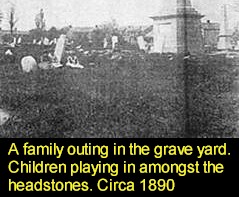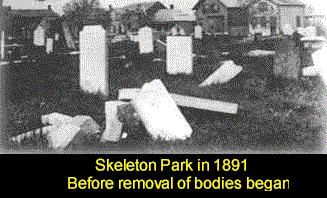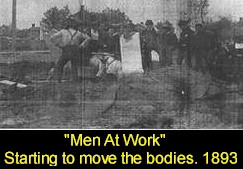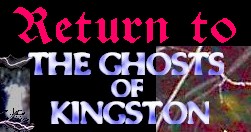
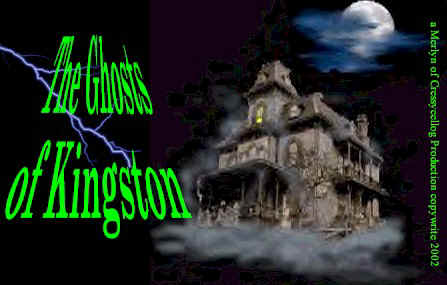
100% Canadian Site
Royal Military College
Queens University
Ghost Photos
Ghost Hunting Tips
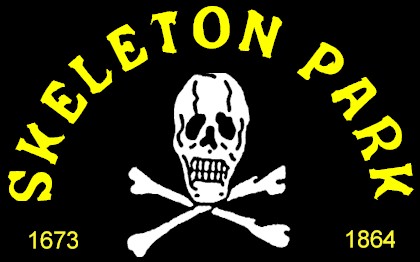
By
Merlyn of Cressycellog
*Go To the Skeleton Park Photo Page*
I have a rather creepy piece of knowledge that I would like to share with the world in general. It concerns a park in my town, a nice park by all modern standards. It is a small park in size, about a city block and almost square in shape.
It has your standard large ancient trees and a play area with swings and slides for the little ones and even a few monuments and plaques. In the winter they gather together some old wooden boards and slap them together and call it a rink and they even have provided lights so people can skate at night. Yet the park is seldom used at night and most people stay away from the park after dark. It is not the possibility of crime or gangs hanging out in it that keeps people away from it but the unseen and the knowledge of what is under the grass that upsets people.
You see the park wasn't always a park, it was once the town graveyard.
The city of Kingston Ontario is not old by European standards but it is right up there with some of the oldest cities in North America.
The native peoples around the Great Lakes have been coming to the area to fish and hunt since long before the birth of Christ. There is archeological evidence that they were setting up campsites just a couple of thousand years after the glaciers retreated.
The first white man to set eyes on the river and the shoreline of the land now known as the City of Kingston was Samuel De La Champlain some time around 1654.
Several years later, in 1673 to be exact, a voyage of discovery set out from Montreal led by the Compte de Frontenac. They picked a spot at the mouth of the river where it drains into Lake Ontario and forms a natural well-protected harbor. Here they erected the first structure, a wooden fortress and called it Fort Frontenac.
The fortress was set on a small plain of land close to the waters edge and flanked on the west by a set of rising hills and on the north by a small Iroquois Indian village.
Trade with the Indians was established and the relationship with the natives was at best mediocre. After several minor skirmishes the fortress was rebuilt a little ways inland and to the west from the wooden one and strengthened with brick and stone. It was now quite a formidable structure.
The problems with the natives increased in 1686 and finally the commandant of the fort settled on a plan to solve the troubles. He invited all the leaders and major warriors of the local tribes to the fort for a meeting. When all had arrived he had his soldiers set upon them and take them captive, he then had them moved out of the area and placed in slavery aboard the ships of Louis XIV.
Needless to say that the remaining natives were quite upset with this trickery and began to attack the local inhabitants with a vengeance. The settlers that had accompanied the troops and helped supply the fortress with food were driven out of their fields before harvest time. They also attacked and basically stopped all travel into and out of the area by the French. They were isolated and eventually forced into a situation of famine by the Indians.
In the spring of 1687 a total of ninety-three soldiers died of Scurvy. Unfortunately there are no records to be found that state where these 93 men were buried. It is the opinion of this writer and not backed up by any evidence that is available that this is the birth of the site known until 1827 as the Garrison Burial Ground.
This piece of land lies atop of the hills directly to the west of the fortress and approximately a thousand yards from it. It was the practice in those days to locate burial grounds within easy walk of the town but outside its borders. It was also common practice to place graves on top of hills, I suppose there is a reason for this but I am unaware of what it is.
The Governors of New France decided that it was not worth while to maintain the fortress and in 1689 they ordered the fort destroyed and the troops returned to Montreal. It is not known if the settlers all returned with the soldiers but there is no record of any remaining in the area.
There was a change of heart by 1695 and the French troops returned and rebuilt the fortress on the foundations of the original one. This second attempt to colonize the region seemed to be more successful and the French Garrison prospered until 1758.
On August 25 of that year Fort Frontenac was attacked and besieged by an English force led by Lt./Col. Bradstreet.
The English had come prepared to overpower the French, they had manhandled a battery of field guns from the fortress at the tip of Lake Champlain and set them half way up the hills between the fort and the burial ground.
From their position on the hill they pummeled the French fortress for a day and a half until it surrendered. Col. Bradstreet being a fair man accepted the French surrender and sent all the soldiers packing back to Montreal and took possession of the fortress. The city remained in English hands until the country of Canada came into existence in 1867.
There must have been casualties during this conflict but there is no record of how many there were or where they buried them. We can only assume that they used the same burial ground the French did and placed their soldiers in the Garrison Burial Ground above the place where the guns rained their hail of death down on the fort. The exact spot was marked well on maps and is now known as Artillery Park.
I don't think it is too much of an assumption to think that the English continued to use the same graveyard as the French and I have seen maps of the city from 1814 that show the site labeled as the Garrison Burial Ground. I feel that this proves that it was being used before the maps were made. And since such a short period of time elapsed between the battle and the maps being made that it would have made little sense to have two or three different graveyards at this time.
It is also worthy of note that the size of the Burial ground on the maps corresponds very closely to the present size of the park.
In 1827 the Crown granted the land known as the Garrison Burial Ground to George O'Kill Stuart to be used as a burial ground for the Anglican Church. In later years the Catholic and Presbyterian Churches were also granted the use of the graveyard.
The peak of activity for the graveyard came in the 1830's during the infamous Cholera Epidemic that swept through the city. People were dying from the sickness at an alarming rate. It is said that a minister of one of the local churches complained that he had spent an entire day at the graveyard presiding over one funeral after another.
The men burying the bodies were so over worked that they began burying three bodies to every unmarked grave to save time in the digging. It should also be noted that there were several sites around the city where mass graves have been found in later years, attesting to the drastic attempts to accommodate all the dead.
The strain on the burial ground became overwhelming and in 1864 the city passed a by-law closing the graveyard and banning any further internment there.
With the Burial Ground closed it eventually fell into disrepair and according to the residents of the streets now surrounding it, it became an "eye sore".
They complained to the city in 1891 and the city ordered that the graveyard was to be moved and the site would be made into a park.
The removal of the bodies began in 1893 and the city has a bill on record from a George Adsit for the removal of some 540 bodies at a cost of 50 cents each. The bill also lists the cost of moving 167 boxes of remains to other cemeteries at a cost of 25 cents apiece.
Wealthier families had their ancestors moved by private means but this would have been only a small number of the bodies.
The removal of the bodies was brought to a screeching halt by the same people that demanded the city do something about the site in the first place, the residents of the area.
Because of the over crowding the gravediggers never knew what they would find when they opened a grave. The event that comes to mind that would have caused quite a stir at any point in history was thus; a grave was opened and in it was found the bodies of two soldiers still dressed in their uniforms. The bodies were pulled from the grave and left lying on the ground beside the hole to await removal. Residents saw the uniforms and immediately thought that the soldiers might have been victims of the Cholera Epidemic. Fearing that the disturbing of the bodies might bring the awful epidemic back they immediately petitioned the city to stop removing the bodies.
Frustrated the city fathers saw fit to halt the activities and have the remaining headstones turned down into the soil and the site plowed under. They then planted the trees and grass that still exist.
Only one monument remains, it would have been too costly to dismantle and re-erect at another site and by this time the city was fed up with the whole business. It is a massive stone monument to the first Anglican minister.
No one knows exactly how many people are buried in the Garrison Burial Ground because the records are sketchy at best for the early years but several individuals have attempted to place a figure on it. The best guess was recently made and it estimates that there were at least 10,000 bodies in the ground.
Now you have to remember the size of the graveyard, it is only about the size of a good city block. The graves would literally have to be shoulder to shoulder and one on top of the other to accommodate so many. If you give the benefit of doubt in favor of the number of bodies removed at 1,000 there are still 9,000 bodies under the ground beneath the trees and the swing sets.
This is a very chilling and horrific thought.
A Public Works crew from the city was digging on Alma Street adjacent to the park on September 22nd 1992 when it came across a headstone buried in the ground. The stone read:
"In memory of William Reynolds native of Pembrookeshire South Wales who died August 12 1834 aged 48 years."
Under the stone they found the remains of Mr. Reynolds.
All work was stopped until the city figured out what to do. It was then that the city found out from the Provincial government that the Garrison Burial Ground had never been recognized as a graveyard, because of this a police investigation was required as well as a provincial inquiry.
The only way to avoid this happening every time remains were found the city would have to officially close the park and officially open the graveyard again and then officially close it and restore the park but only after the removal of all remains.
The Province and the city finally came to an agreement that as long as the land was never used for anything but a park the city would not be required to remove all the remains only the ones found during the process of normal work and repair.
So McBurney Park, as it was called when created in 1894, will always stand in the center of our fair city. Trouble is very few people here know it by its real name, they have grown up like myself calling it Skeleton Park. Very few actually knowing the real reason it is called that.
688 King St West
The true story of a haunting that one
family had to live with

McBurney Park
The city park that holds a horrible secret
 The Mystery
of King Bird Five Zero
The Mystery
of King Bird Five Zero
